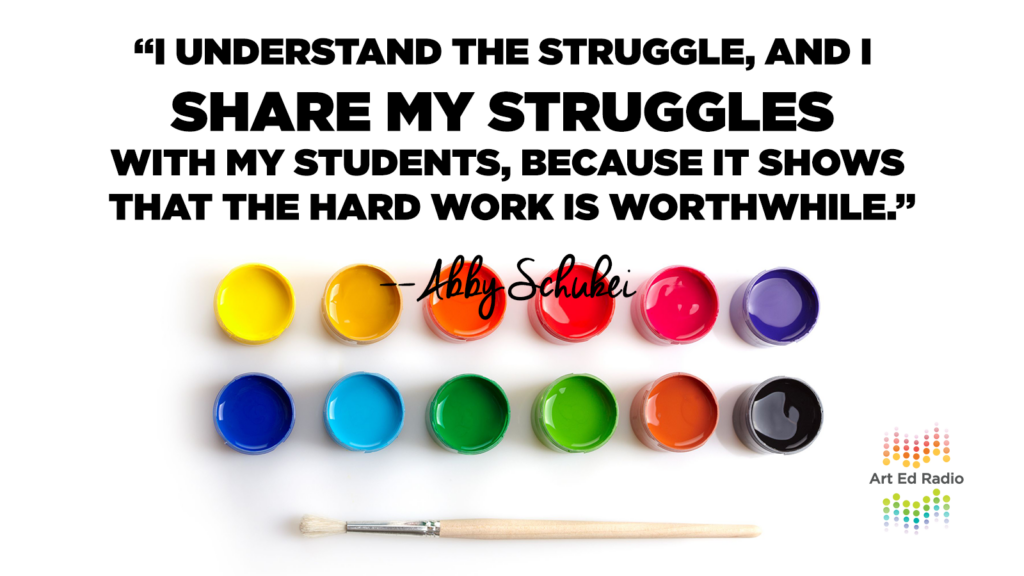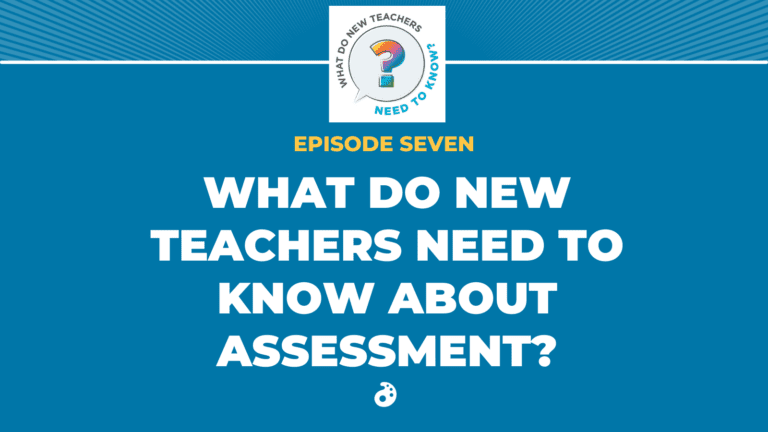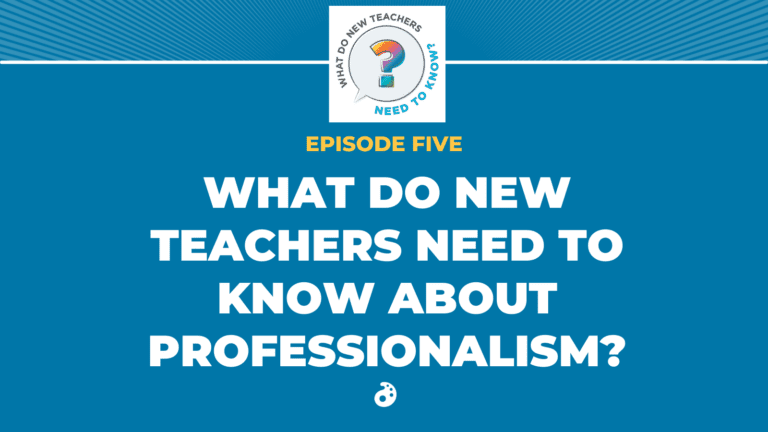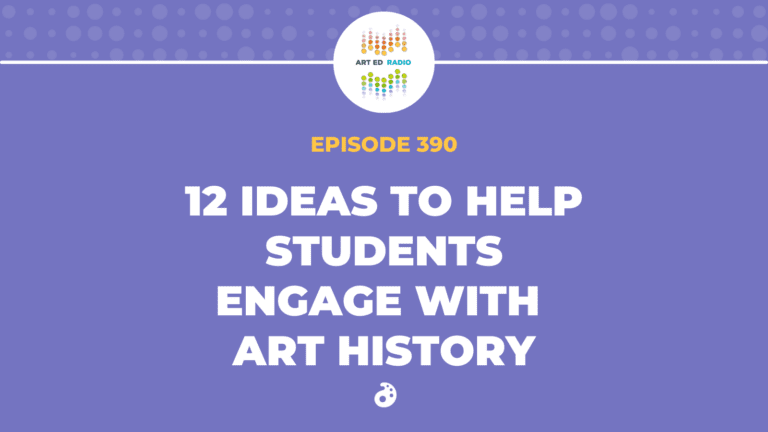Art teachers are asked to do so many different things when it comes to media and subject matter. Inevitably, we’re going to run into something in our curriculum that leaves us feeling uncomfortable. AOE writer Abby Schukei joins Tim to talk about the approach you can take when you’re not comfortable with content (7:30), how much you need to prepare before you teach techniques (10:30), and how to deal with teaching things that aren’t always exciting (15:45). Full episode transcript below.
Resources and Links
- Adding Excitement to Art History
- Making Boring Drawing Fun Again
- Abby’s First Appearance on Art Ed Radio
- All of Abby’s articles for AOE can be found here

Transcript
Welcome to Art Ed Radio, the podcast for our teachers. This show is produced by The Art of Education and I’m your host, Tim Bogatz.
So last week on the podcast Ryan Loeppky was on and he and I talked about how, as teachers, we always need to be improving and how we always need to be looking for new things to try, new ways to improve, and new ways to get better at what you do. And a big part of that is kind of realizing where your weaknesses are as a teacher. And so, that got me thinking about other ways in which we try and improve and those are the choices we make ourselves. These are the professional development that we take on. Whether that be courses that we take, or the articles we read, or even these podcasts that you listen to, to actively make sure that you get better. And you should be commended for doing all of those things because it is so important for you to continue to try and improve.
But what I want to talk about today is, what happens when your hand is forced? And what happens when, rather than choosing to get better, you are forced to get better? So how does that affect you when you have a lesson that you want to teach or part of a curriculum that you’re required to teach but you’re not comfortable with the content? I know that’s something that affects a lot of teachers, especially in their first few years. It’s something that affected me really badly when I was first starting as a teacher. And I want to talk about that today.
And now, I know, you’re probably thinking last week we talked about pointing out our weaknesses and how we can improve, and this week we’re talking about the subject matter in the media where you’re not comfortable, where you’re not good at it and what to do when we struggle? And you’re probably wondering, “Tim, Andrew’s only been gone for three weeks. Are you falling apart already?” And the answer is maybe. You know, I love talking about things that we know a lot about. I love talking about things that you’re confident in. But, honestly, I think it’s important that we talk about things that we aren’t great at. It’s important that we identify your weaknesses and, more importantly, talk about exactly what we can do to get better.
Like I said, it’s definitely fun to talk about all the things you’re great at and the things you enjoy but nobody’s teaching situation is exactly like that. And there are times that you are going to struggle. There are times when you don’t know what you’re going to do or you don’t know how to do it. And I think we need to embrace those for a couple of reasons. First, it’s the perfect way for us to improve and that’s everything that we talked about last week with Ryan. You need to challenge yourself if you want to get better. And secondly, we need to show our kids that it’s okay to struggle. It’s okay to not know everything.
That’s what I want to talk about today. Abby Schukei will be here in just a minute. Or more specifically, she’s here right now waiting for me to get through this terribly long intro cause we’re going to record this in person. And, honestly, I think she’s getting kind of annoyed that I’m taking so long. But we’re going to talk about what to do when you’re not comfortable with content.
But first, I want to tell you about the Art of Ed Studio Ceramics course. I also want to tell you that Abby’s glaring at me because she didn’t know there was an ad coming too, but her mike is off so she can’t do anything about it. But I know Abby is taking the Studio Ceramics course right now, I know she loves it. It’s a chance to both make your own work and learn techniques for your classroom. You can experiment with hands-on techniques using slips and under-glazes, texture treatments, doing advanced hand building stuff, and you also learn about how you can create interdisciplinary connections. It’s an eight-week course on ceramics you can take it for three graduate credits and you can sign up today. There are new sections beginning in April, May, and June. You can check it out at theartofed.com/courses.
Okay, now it’s time for Abby. Let’s go ahead and get started with our conversation.
All right. I am here with Abby Schukei. Abby, how are you?
Abby: I’m doing good. How are you?
Tim: I’m doing really well. I’m excited to talk to you and I’m excited about the topic today. Just kind of talking about what you do when you’re not comfortable with the content you teach. So let’s start off, I don’t want to say easy cause I’m making you admit stuff, but what’s an example of a subject that you don’t like to teach or that you don’t want to teach? Or, maybe just an example of something you’ve had to learn and get better at as a teacher.
Abby: Well, I’ll start off with something that I don’t like to teach, which is drawing, which I know you love to draw.
Tim: It breaks my heart a little bit that you’re saying that but that’s okay.
Abby: I just find it really challenging to teach drawing just because my focus was always on painting. So I loved the drawing aspect of as you start out but the paint was the medium that really brought it to life. So I have a hard time teaching drawing to my students just because there’s so many different things. Students come in at different levels and I just don’t really enjoy teaching it so much but it’s kind of important. It’s like the foundation to all drawings.
Tim: Yes.
Abby: So, yeah, that’s a challenging thing for me that I just don’t like. And, I guess, the one that I kind of don’t know anything about is like fiber arts.
Tim: Same, same. I know so little about fibers.
Abby: I can paper weave and that’s about it. Maybe make those God’s Eyes, which is okay. I used to sell those at garage sales as a child. But that’s it and I follow a lot of cool macrame artists on Instagram, and it looks so awesome but I just don’t even know how to get into it. So maybe I’ve got to figure that out. I think it’s probably something that my students would like to do, but I just don’t know how to do it. And then, I guess, I don’t know, something that I kind of have learned to like, or I had to teach myself is watercolor. So yeah, those are kind of my things.
Tim: Yeah, I feel like a lot of teachers are like that with watercolor because everybody knows the basics but there’s so few people out there that know any advanced techniques or really get into watercolor. It’s so rare.
Abby: And I think probably every single art teacher listening has divided their paper up and practiced like six different, nine different watercolor techniques.
Tim: Yes.
Abby: But then it’s like, how do you actually apply those things?
Tim: Right. Right.
Abby: I mean, I remember doing those watercolor techniques when I was in sixth grade.
Tim: Yes.
Abby: I remember them, I really do, but now it’s like what do you do with them?
Tim: Yeah. How do you put that to use?
Abby: And that took me a long time to figure that out. Like how to show my students what to do with them.
Tim: Yeah, exactly. And I guess that kind of leads me into my next question. If you have a subject that you’re not really well versed in, or a media that you need to learn a little bit more about, how do you go about that in your classroom? I’m going to give you three options here. Option A, do you research and then practice, and practice, and practice until you’re comfortable doing it and teaching it? Or do you just tell the kids, “Hey, we’re just winging it here,” and dive in? Or is it kind of a mixture of both?
Abby: Definitely a mixture of both. I think probably there are certainly times where I know I want to teach something but I don’t know how to do it. Because one of the things, art teachers are expected to know so much.
Tim: Yes.
Abby: And so probably actually half … I would say most of the stuff we teach we actually never did it before we researched it. So I do a lot of researching, but there are totally times where I just kind of wing it, and when I do that, I think it’s really important to be honest with your students that you’re doing that. And it kind of be like a learning experience together and you guys can kind of teach each other as you go. I kind of always like to take the approach of, “Hey, I really don’t know how to do this, but let’s learn it together.”
Tim: Yes.
Abby: And we’ll kind of work through the problems and things like that. A specific example recently is, I recently started using a lot of epoxy and resin with my students. Not something that I had not done before, never used before. Some students saw something on YouTube and they were like, “I want to do this.” And I said, “Okay, let’s do it.” But I was like, “Oh, man, how?” So we just did some research and now we use it all the time just because a student actually asked if we could do something. So I think it’s cool when you’re able to bring both of those sides into the art making process.
Tim: Yeah. I think that’s a really good way to go about it and it kind of gets me thinking about what I want to ask you next because I want to just tell you, when I first started teaching, I was definitely an Option A person, research and practice, and practice, over and over because I was so nervous. I felt that pressure that you’re talking about of having to know everything and having to be the expert on everything. And I was so afraid. I couldn’t let my kids see that I didn’t know how to do something. You know, but my thinking has kind of evolved.
My first couple of years I was just so nervous about presenting a demo. I didn’t know do this and, oh my god, the world’s going to end if I mess this up. But then my thinking kind of evolved and so I got to the point where I was more than comfortable saying, “Hey guys. I don’t know how to do this yet. I’m still learning too.” But, like you said, let’s do this together. And so, I guess, my question is, has that happened to you? Has your thinking evolved? Have you always been the same way as far as just winging it and diving in? And on top of that I guess, how would you suggest teachers approach that? Should they be an expert or do you think they need to just dive in with their kids and give it a try with them?
Abby: I think it’s okay to do a little of both and, obviously, I think it’s going to change with your experiences. Starting out at the elementary level, like I did, it was a lot easier to kind of not be as prepared because sometimes like your students aren’t really going to know if you don’t know.
Tim: Yes. Yes.
Abby: But now I’m definitely at the secondary level. It’s important, cause you want to show them more advanced techniques and options, and just all these really cool processes that you do need to be prepared for but I think it goes back to being … its important about having an honest communication of, “Hey, I haven’t done this before. I’ve been researching this stuff but it might not go as planned.” So I think it’s just kind of important to kind of lay that out like that. And I think I’ve always kind of been that way but definitely I’m more transparent with my secondary students now.
Tim: Well, and they’re going to call you out too.
Abby: Oh, for sure.
Tim: Right? You need to be honest with them. We talked a little bit earlier about how we need to be an expert in every area. And obviously, there are things that we love more than others. Me drawing, you, painting. We’re required to teach so far beyond our comfort level or our strengths. And so, I guess, what would be your advice? How do you push through and go about teaching those things that you aren’t as good at or that you don’t feel as comfortable doing?
Abby: Well, I think one of the things. I told you that I don’t really like to teach drawing, but you never told me what you like to teach. So, we’ll get back to that. But I don’t really like to teach drawing and, I think, one of the things it comes down to is, I remember when I was a student and learning how to use a grid, and my mind just not work that way. I remember my high school art teacher. I can envision myself in the art room, and I hated using a grid. I couldn’t do it. And so, I understand that struggle a little bit with students. And I tell them, “Hey guys. I absolutely hated to do this, and I was not very good at it. And I don’t use it now today just because it’s much easier for me to look at something rather than to grid it out.”
Abby: And I know plenty of my students don’t work that way. So I think, if you’re able to share some of those experiences with your students. And I, obviously, I’ll lie a little bit to them and say, “I really hated doing the grid technique when I was growing up and learning how to do this but, because I do know how to do it, I was able to do X, Y, and Z.” So, you know, you kind of flourish it a little bit.
Tim: Yeah.
Abby: But it works, and I think, if you’re able to give those kind of concrete examples, it helps. Another one that I always do with my students, kind of going along with that is, when we throw on the wheel, I still have my very first piece that I made in seventh grade.
Tim: Nice.
Abby: And it is terrible. It’s not centered and it’s like curled. And my students make fun of me. And I was like, “Okay. Well, you’re going to do better than this.” And they all do. So, if you’re not comfortable teaching some of those things, just kind of go from your own experiences and it’ll just all be okay. It will be.
Tim: Yes. Yes. I think embrace it is the way to go. And so, you hit so many good points. But I want to follow up on three of them really quickly.
Abby: Okay.
Tim: Number one, grid drawing. I don’t want to dive too teaching that but I always just tell kids, just do it once. Just try it once. If it works for you, you can keep doing it, it’s a tool in your tool box and you can keep building on that. And, if you hate it, that’s fine. Just try it once so you know everything about it and you can say, “Oh, I never want to do this again.” That’s fine but just try it once and see how it works for you. For some people it does, they continue to use it. Some people like you, never use it again, and I’m okay either way. But as long as they learn how to do it once, I’m good.
Abby: Yeah, actually I had a student today that, she’s an eighth grader. And, in seventh grade, we do a grid drawing cause that’s a tool that they should learn. And I heard her talking about something. She was like, “Oh, I liked it when we did those portraits and we did a grid.” And I was like, “You know that you can use that now.” She’s like, “Oh.” “Cause, if you like doing that, we can do it now.”
Tim: Yeah.
Abby: So I guess it does stick. It does work for some kids.
Tim: No, it definitely does. And I also think that, like you said, showing kids your old work is fantastic because my high school kids are ten times better than I ever was in high school.
Abby: Yeah.
Tim: But I still have all my stuff. And so, when kids are feeling down on themselves and they’re not real happy with their work, we break out the old portfolio and go, “Look what I was doing at your age.” And then they just laugh at me cause that’s really the only appropriate reaction when you see my high school work.
Abby: Oh, man. Give yourself a little credit.
Tim: I’ll show you sometime. It’s terrible. And the third thing, like you said, just embrace that attitude and give them a goal. Show them your seventh grades, your own piece and say, “Hey, you’re only goal is to do better than this.” And it gives them something to shoot for and I think that works.
So let’s dive back into, I guess, more of those ideas on things that you maybe don’t want to teach. So what do you do when there’s something that’s required by your curriculum or something you have to teach but you absolutely hate it. What’s your mindset in that case?
Abby: Find a way to make it exciting. You know, there’s some … if you’re going to do … let’s talk clay here for a second.
Tim: Okay.
Abby: Okay? I know there’s so many good hand building techniques that students should learn how to do, slab building being one of them. But man, can we go beyond just like basic slab boxes?
Tim: Let’s build a box.
Abby: Yes. And you know, I see that all the time and sometimes they’re really awesome. But it’s kind of boring.
Tim: Yes.
Abby: It’s kind of boring. So I kind of, you know, how can you take something up a notch a little bit? What can you do to kind of level something up? And I think you go about that, going back in and just using your resources, whether it’s a YouTube video, or just being inspired by other art teachers that you follow on social media. Or, I don’t know, go to the library and check out a book of something you never … sometimes I do that and I’m like, “Wow. I would never have just got that on the Internet.”
Tim: There was the one time I went to the library and I found a book on printmaking. It was from 1972 and I’m like, “Okay. Let’s just give it a shot.” And then it showed me this process for carving into plaster, like blocks of plaster and then doing prints from that, which I had not done before.
Abby: I have not done that.
Tim: And so, hey, books from 45 years ago, let’s see what you got.
Abby: Yeah, sometimes bringing out the ancient things can be new again, can be exciting.
Tim: Just find those resources. Yeah, so that’s cool.
Tim: Okay, so I guess though, as we’re kind of wrapping this up, cause I don’t want to talk too long about all this stuff that we hate teaching. If we look big picture at this, in the long run, doesn’t kind of fighting through these struggles and teaching those things you don’t love so much, finding new ways to do it, finding ways to make that exciting. Doesn’t all of that put together make you a better teacher in the long run?
Abby: Oh, absolutely. And we have to remember that we’re doing this for our students. And, even though maybe I don’t like to teach drawing, I know that so many of the students in my classroom want to draw, they love to draw. So I am not benefiting them, if I’m only teaching what I like, which we should hopefully not be doing that.
Tim: Yes.
Abby: But, it’s just one of those things. I know, I always ask when I get a new group of students in. The first thing I always ask them is, what is one thing you want to be able to do better? And, of course, the answer is always I want to know how to draw better. I want to draw realistically.
Tim: Can I interrupt real quick.
Abby: Please.
Tim: And just tell you, that’s why I love teaching drawing. That’s what it is because every kid who comes in to your classroom, well, not everyone. But they say, “I want to learn to draw better.” And so, I don’t know, I feel like, if we can teach them to do that well, they just have so much pride and such a feeling of accomplishment when they can do that. And that’s what I love about teaching drawing.
Abby: I see your point there. Okay? But, I’m going to kind of go in the opposite here, but I hate teaching drawing because students think it’s hard. They don’t want to work to it and there’s so many things that they have to put together, and you have to practice. You have to do all these things to become good at drawing. And I think I see a lot of reluctancy from my students in that regard. So, man, I know they get better but maybe I should just try to love it a little bit more.
Tim: Embrace the process, Abby.
Abby: Yeah. Okay, now you still have to answer the question.
Tim: Okay.
Abby: What is your least favorite thing that you don’t like teaching or not comfortable teaching?
Tim: Oh, definitely watercolor.
Abby: Okay. All right.
Tim: Okay, so I’ve talked on this podcast a million times about how I got all through high school and all through undergrad without ever doing ceramics. I never had a ceramics course. And so, when I first started teaching clay, it was a struggle. Let’s be honest. It was a nightmare actually. But, I came to love it. Like I got good throwing on the wheel eventually. And I really kind of learned to embrace like everything ceramics, glazes, and techniques, and tools, and everything. But I’ve just never found the joy in teaching watercolor. Like you said, you do your exercise. Like, let’s do it on wet, let’s add some salt, let’s dry a dry brush. But then, how do you translate that into anything really? You talked about how we need to make things exciting for our kids and I’ve never found a good way to do that with watercolors. So anybody listening, if you have great watercolor lessons or great watercolor ideas, shoot me an email and we can talk some shop.
Abby: Yeah. Show us how you use and apply all those watercolor techniques that we’re making our students do.
Tim: Okay. I love it. That’s kind of a terrible, but kind of a great place to end it, I think.
Abby: Yeah, I love it.
Tim: Cool. Cool. Well, Abby. Thanks for joining me and, hopefully, next time you come back on, we can talk about things we love rather than things we hate.
Abby: Sounds good.
Tim: Alright. Thanks.
Alright. Because of that really long intro and that long interview, we’re going to wrap this up really quickly here. I’ll just say this. It sounded like we were joking when I said that I’m looking for new cool ways to teach watercolor but I’m serious. So, if you have any sage advice, any words of wisdom, or any suggestions for me about great things to do with watercolor, send them my way.
And, I suppose Abby and I aren’t going to agree with the drawing thing. I’m always going to love teaching it and she’s not, and that’s okay. Like, that’s the point, right? Because, if we can wrap this all up into just one sentence of this whole discussion today, we need to keep finding new ways to explore and embrace what we’re not always great at. And we need to help our kids do the same.
Art Ed Radio is produced by The Art of Education with audio engineering by Michael Crocker. Make sure you check out The Art of Ed website this week. It is sculpture week and we’re talking about all kinds of ideas for incorporating more sculpture in the classroom. Abby has an article that I think was published yesterday. I’ve got one coming later this week about some of my favorite contemporary sculptures. Everything there this week is some good stuff, as it always is, but it’ll be worth your time to check it out at theartofed.com. We’ll talk to you next week.
Magazine articles and podcasts are opinions of professional education contributors and do not necessarily represent the position of the Art of Education University (AOEU) or its academic offerings. Contributors use terms in the way they are most often talked about in the scope of their educational experiences.



